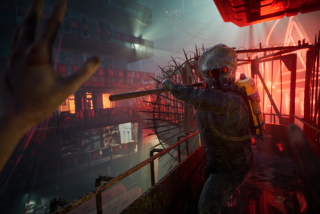The Player: Why ‘Oxenfree’ may just be the first must-play game of 2016
Young superheroes were once at the heart of the game Glendale’s tiny Night School Studio set out to create as a reputation-making title. Then the company’s two lead designers hit on characters even crazier than those with unexplainable powers: ordinary teenagers.
Scrapping the superhero idea is not the only leap of faith that Sean Krankel and Adam Hines, cousins who co-founded Night School in 2014, are making with the game they call “Oxenfree.”
The company — essentially six people crammed into a hallway-thin office near Glendale’s GameHäus Café — is betting that players will be open to an independent game with a funny name and is counting on audiences being hungry for story and characters placed at the forefront, above all else.
See the most-read stories in Entertainment this hour >>
The star of “Oxenfree” is Alex. Her mom has just remarried, she barely knows her stepbrother and her own brother died under tragic circumstances, an event that ripped her parents apart. The game’s biggest challenges deal with communication — among friends and, occasionally, with ghostly, scary beings.
Think “Poltergeist.” Or maybe “The Goonies.”
“Oxenfree” mixes its terror with plenty of playfulness, creating a game in which wonder and ambiguity rather than pure frights and boos are a priority. It’s a little game that looks big — it’s set on a decommissioned military island that may or may not have a mind of its own — and it’s being developed by alumni of Disney Interactive and Telltale Games.
What’s more, with its deft mix of lively characters and casual conversations, “Oxenfree,” due for release for PCs and the Xbox One on Jan. 15, may be one of the first must-play games of 2016.
Cleverly, “Oxenfree’s” mysteries are unraveled by instructing the characters to use an old radio to dial into what are perhaps otherworldly frequencies, but often the teens prove to be just as out of tune with one another as they are with the game’s supernatural elements.
Ghosts, after all, are creepy, but prom is terrifying too.
“The idea, when we were starting the studio, was story,” Krankel says. “We had always really been into stories in games, but at the same time it only feels like it’s in the last two or three years where there’s been this serious appetite for story — and improving stories — in games.”
There are nods in “Oxenfree” to the so-called adventure games of yore. Whether it was the tales of King Graham in the original “King’s Quest” or the heroic accidents of Guybrush Threepwood in the “Monkey Island” series, games once regularly attempted to marry puzzles with a novel-esque approach. Yet the mightiest games on home consoles rarely took such a detailed look at narrative, and while game worlds became increasingly expansive, they were often thin on plot.

Lead programmer Bryant Cannon, left, designer Kevin Riach (holding up Sean Krankel, CEO), Creative Director Adam Hines, designer Spencer Stuard and lead artist Heather Gross are all part of the team behind Night School Studios.
Developers likewise took a blank-slate approach to a game’s main character, wanting he or she (but usually a he) to be a stand-in for the player. All of that has begun to change in recent years.
“King’s Quest” is back, and developers including Naughty Dog (“Uncharted,” “The Last of Us”), “Crystal Dynamics (“Rise of the Tomb Raider”) and Telltale Games (“The Walking Dead,” “The Wolf Among Us”) are all making the case that story — and fully developed protagonists — matter.
For “Oxenfree,” Krankel says, “We were trying to create the most realistic, naturalistic characters possible and have the scenario be the crazy thing. We didn’t want to stick you in the shoes of an astronaut or a dragon slayer or whatever. You’re a 17-year-old girl and you’re about to deal with all the same natural stuff that a 17-year-old deals with — awkward social interactions and trying to impress somebody, or having your feelings hurt. If someone offers you a cigarette, what do you do? There are benign teenage interactions.”
SIGN UP for the free Indie Focus movies newsletter >>
When “Oxenfree” begins, Alex is traveling with a friend to an island, a place that’s a tourist trap by day but deserted by night. The plan: sneakily stay on the island after curfew and do illegal substances around a bonfire.
Things of course go horribly wrong, but “Oxenfree” is more weird than catastrophic. As Alex struggles to get to know her new stepbrother — she can be polite or aloof or a mix of both, depending on the player’s choices — the island starts to come alive.
“When the crazy stuff happens, then it feels huge and extra crazy and weird,” Krankel says. “We wanted to make it feel grounded. It’s just a natural teenage experience that happens to be screwed up by ghostly creatures.”
Visually, the game takes a wide-screen approach, letting luminescent caverns or World War II-era military towers fill the screen. Alex and her peers unwittingly open a sort of rift in time, which inspires the game to sometimes break apart like an old VHS tape. To create the ghastly figures of the game, Krankel says he and his cousin attempted to visualize the spectral image of “a radio station between two stations.”
Krankel, 38, and Hines, 32, who grew up near each other in suburban Chicago, cite the Steven Spielberg films of their youth as a primary inspiration, especially works Spielberg helped produce such as “Poltergeist” and “The Goonies.” Like the latter film, “Oxenfree” is set in the Pacific Northwest. The Night School founders even attended a 30th-anniversary celebration for the film in Oregon, which in turn led to the game’s look and tone.
Hines, author of 2010’s graphic novel “Duncan the Wonder Dog,” wrote much of the 1,200-page “Oxenfree” script. The goal was to create a game that never cut away for cinematic or choose-your-own-adventure-like sequences. Walk, talk and play at once.
Direct Alex away from her friends, and she’ll be called out. Feel free to have her interrupt someone else who’s already talking. If Alex says one thing and then does the opposite, she’ll be questioned. What stands out in early plays of the game is just how free-flowing its conversations are.
“In pretty much every other story game you have moments where you can interact and impact the plot, where you’re talking and get to choose what to say,” says Hines, who worked on Telltale titles such as “The Wolf Among Us” and “Tales from the Borderlands.”
“It’s kind of kept in a box separate from the rest of the gameplay, where you’re running around and shooting or pulling out your sword,” Hines continues, adding that he wanted a game where there were no breaks between dialogue and action. “So you can talk to people and run around and do the gameplay parts too. We want the story and the gameplay to be as one.”
In short, to make conversing the game. That’s where the radio comes in. The radio can tap into the island’s other, harder-to-see inhabitants.
“If the way you communicate with your friends in the game is by talking,” Krankel says, “then the way you communicate with the other stuff on this island is this radio.”
Independent and only a little more than a year old, Night School’s future is riding on the success of “Oxenfree.” Krankel and Hines keep their studio stocked with just the essentials; coffee, chips and other snacks; a TV, a small couch and a table of computers.
Krankel met or worked with many of the team while he was at Disney, where he’s had multiple stints. “Oxenfree” thus has a professional sheen, but now comes the hard part: finding an audience that will appreciate a talk-heavy game with supernatural elements.
The two don’t think of what they’re doing as experimental. “Oxenfree” is simply an attempt to make old-fashioned storytelling more interactive.
“We want the game to feel as creative as possible but also as broadly appealing as possible,” Krankel says. “We are not, like, throw-ourselves-on-the-dagger artistes.”
While Krankel and Hines won’t reveal a budget, Krankel mentions the studio has enough cash for one game — “Oxenfree” — and then will evaluate its prospects.
Still, he tantalizingly teases where the company could head next. “It may be a romantic comedy.”
------------
‘Oxenfree’
Developer: Night School Studio
Platforms: Xbox One, PC
Release date: Jan. 15
Price: $19.99
More to Read
The biggest entertainment stories
Get our big stories about Hollywood, film, television, music, arts, culture and more right in your inbox as soon as they publish.
You may occasionally receive promotional content from the Los Angeles Times.











